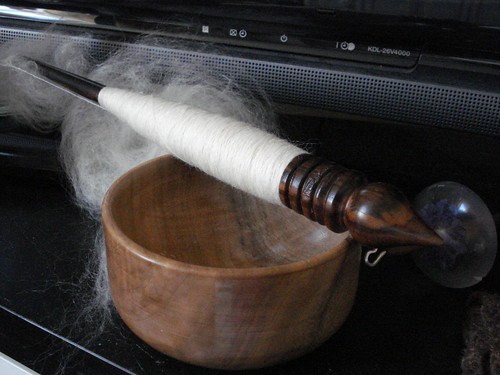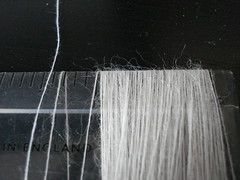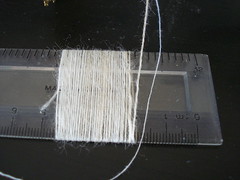I just recently got a secondhand Russian spindle. Russians are support spindles, not drop spindles - instead of hanging suspended in the air, their pointed tip spins in a bowl, like a top. Support spindles are great for spinning ultra-short fibers or ultra-fine yarns, because they can spin very fast and there's nothing weighing the yarn down. As a drop spindle spins and accumulates a cop, the spindle becomes heavier. A supported spindle effectively weighs nothing, or very little, because it's not hanging in the air.

You don't have to be the world's best spinner to spin very fine lace yarn on a Russian spindle. The singles that I'm currently spinning measure over 80 wraps per inch, and my plied sample was 36 wpi. Here are some tips.
Park and draft. Remember when you were just learning to spin, and you would spin the spindle, hold it in your lap, and then draft out the fibers and let the twist into them? It's regarded as a beginner's technique, but it's great for letting you take your time. Especially if you're just getting used to using the support spindle, park and draft is perfect. By slowing down the process and not requiring you to do everything at once, you can get a lot more control, making sure your yarn has enough twist and making the yarn as thin and even as you want it.
 |  |
Singles and plied yarn, with sewing thread for scale.
Tons of twist. The thinner a yarn is, the more twist it needs. Obviously, cobweb lace weight needs a lot of twist to stay together. Luckily, support spindles are good for this. They can spin very fast, imparting enough twist into your yarn. Make sure you test your length of yarn before winding it on to your cop, to see that it doesn't drift apart from lack of twist. If it's too weak, give the spindle an extra flick.
Careful drafting. An even yarn will prevent sections pulling apart - twist goes to the thin spots over the thick ones, so if you have a section of super-thin yarn next to a thick section, the thick section could pull apart. In super-fine yarns, neps and slubs are the enemy. Remember to keep your yarn under tension to avoid 'pigtails' or 'corkscrews', which will also suck twist out of other areas of your yarn.

Good fiber selection. A fine fiber spins a fine yarn. Short down fibers such as cashmere, camel, or yak love to be spun thin. Silk can also be spun very fine. As far as wools go, choose something soft and short like merino or rambouillet. Be careful of anything with too long a staple length, as it may be difficult to spin. Good prep is also very important - the fiber needs to be smooth and airy. Anything neppy, felted, or compacted will not yield a good fine yarn. The better the prep, the easier it will be for you to spin it.
If you take your time, pay attention to your drafting, use appropriate fiber and put in enough twist, you'll be able to spin very fine!
~Joyuna

 The Grateful Crane Shawl
The Grateful Crane Shawl Elven Slippers
Elven Slippers Russell Square Mitts
Russell Square Mitts Russell Square Tam
Russell Square Tam iTouch Jumper
iTouch Jumper Twisty Wristband
Twisty Wristband Mawata Pulsewarmers
Mawata Pulsewarmers
I have recently been bitten by the spinning bug and have mad love for fine gauge knitting (as does my knitting machine). This post is brilliant. I will definitely be looking for a similar spindle. Thanks for sharing this information!
ReplyDelete